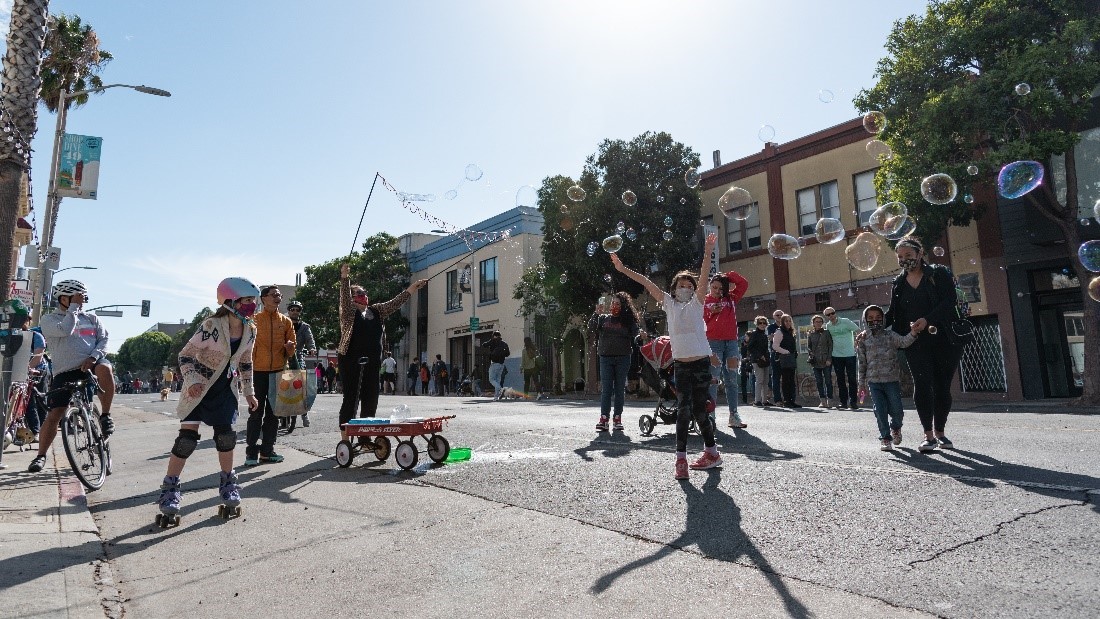
Children and families playing during a Sunday Streets event
Over the past two years, Slow Streets have shown how simple designs that prioritize people can transform streets. Suddenly, streets across San Francisco filled with the sounds of kids playing and neighbors chatting. They filled with people on bicycles and people rolling in wheelchairs; with joggers and dog-walkers. The streets came to life.
Initially, the SFMTA introduced Slow Streets as an emergency response to COVID-19. People needed space for recreating at a safe distance outdoors. And with Muni service reduced or suspended at the time, people needed ways to travel to essential destinations on foot or bike. To quickly meet these early pandemic needs, we implemented Slow Streets with simple signs and barricades.
Over time, it became clear that Slow Streets served an even larger purpose. They became places for communities to come together. Neighbors organized events like scavenger hunts and Trick or Treat parties around their local Slow Streets. They created art and hosted pop-up musical performances. For many people, Slow Streets encouraged them to shift their lifestyles. Some families sold their cars and began to travel by cargo bike. Older San Franciscans rediscovered the joy of riding bicycles. Fleets of kids gathered to bike to school in organized “bike buses” across the city. Beyond the initial pandemic response, Slow Streets proved critical to meeting some of San Francisco’s most significant goals: Vision Zero and Climate Action.
As the city moves out of the pandemic, it’s clear that Slow Streets have a place in San Francisco. We need to continue to encourage active transportation to meet our goal of 80% low-carbon trips by 2030—and we need to make these trips safe and accessible for people of all ages and abilities. Low-stress streets, like Slow Streets, create transportation choices for a wide range of San Franciscans by making active transportation comfortable, safe, and joyful.
On December 6, our Slow Streets team will bring a proposal for an ongoing Slow Streets program to the SFMTA Board. This post-pandemic program will maintain the same core principles as the pandemic-response Slow Streets. Its goal is to create safe, shared corridors that prioritize people traveling by active modes and making local trips by vehicle. But it will improve on the COVID-response program in some key ways. The proposed program will have a more durable, diverse design toolkit that will include traffic calming features like speed humps, traffic diversion, roadway narrowing, and improved wayfinding signs. And it will use data to make sure that streets are working effectively.
Our goal is for Slow Streets to meet or exceed national standards for low-stress corridors: streets where people of all ages and abilities feel comfortable walking and biking. That means no more than 1,500 vehicles per day, and speeds lower than 20 mph. For each Slow Street, our team will develop a design that reflects specific needs and conditions. We will also gather and analyze data on important safety measures like vehicle volumes and speeds, and adjust designs when needed. We aim to work efficiently and in collaboration with communities to implement these corridors.
Following the meeting on December 6, we will be sharing updated guidelines for using Slow Streets—whether you bike, roll, walk, or drive. These guidelines will create shared understanding for how to behave on Slow Streets to make sure everyone feels safe and welcome. More to come on this soon, but in the meantime, remember: Everyone is welcome, and please go slow!
Initially, we’ll be proposing 15 corridors for inclusion in the program. Most of these streets were COVID-Response Slow Streets that met criteria for continuing them as Slow Streets: high volumes of people walking, biking and rolling, and connections to the citywide active transportation network. Proposed Slow Streets are:
- 12th Avenue
- 22nd Street (proposed as an alternative to 20th Street to align with the citywide bicycle network)
- 23rd Avenue
- Arlington Street
- Cabrillo Street
- Cayuga Avenue (proposed as a new corridor)
- Clay Street
- Golden Gate Avenue
- Hearst Avenue
- Lyon Street
- Minnesota Street
- Noe Street
- Sanchez Street
- Shotwell Street
- Somerset Street
Lake Street, which was already approved as a long-term Slow Street by the SFMTA board, will also be discussed by the board at the December 6 meeting. Existing Slow Streets that are not approved by the SFMTA Board will be removed following the meeting. While the Slow Streets in SoMa are not recommended to continue as a part of the ongoing program, the existing traffic calming and local access restrictions will remain in place to encourage the use of these streets as places for community activation.
This is just the beginning of a program that we intend to grow to meet neighborhood and citywide transportation needs, in partnership with communities. An ongoing Slow Streets program for San Francisco will help our city meet its adopted goals for mobility, safety and climate action—and ensure that San Franciscans can continue to reimagine how their streets can serve them. We look forward to beginning this process and sharing more in the future.
For more information, please see the Slow Streets Fall 2022 Project Update and Frequently Asked Questions.